CASUP - Cellular Automata library for SUPercomputers




CASUP is a general purpose cellular automata (CA) library for
supercomputers and HPC.
CASUP provides routines for domain decomposition, halo exchange,
collective ops, remote calls, etc.
Fortran 2008 and 2018
coarrays
are used extensively, as well as MPI,
OpenMP and do concurrent.
CASUP is distributed under 2 clause BSD-style license.
See
LICENSE
included with the distribution.
CASUP can be used on its own or coupled with
a continuum mechanics solver, e.g. FE, either
commercial:
ABUMPACK
or free open source:
ParaFEM,
to understand the influence of tensor fields
(temperature, stress, strain, strain rate, pressure, etc.)
on microstructure evolution, solidification, recrystallisation, ductile
damage and brittle fracture, magnetisation, etc.
Note that the library was previously named CGPACK (cellular grains package).
New name reflects the fact that the library now has a much wide applicability.
Supported by:






Progress log
MAY-2017
|
APR-2017
|
MAR-2017
|
DEC-2016
|
NOV-2016
|
SEP-2016
|
AUG-2016
|
JUL-2016
|
JUN-2016
|
MAY-2016
|
APR-2016
|
MAR-2016
|
NOV-2015
|
SEP-2015
|
JUN-2015
|
APR-2015
|
MAR-2015
|
FEB-2015
|
JAN-2015
|
OCT-2014
|
JUL-2014
|
APR-2014
|
JUL-2013
|
JUN-2013
|
MAY-2013
|
APR-2013
|
MAR-2013
|
FEB-2013
|
JAN-2013
Feedback and support
With any questions, bug reports, feedback and any other comments
please submit a
ticket.
Documentation
Publications etc.
-
2018:
A. Shterenlikht, L. Cebamanos,
Cellular Automata Beyond 100k Cores: MPI vs Fortran Coarrays,
Proc
EuroMPI 2018 Conf,
23-26 SEP-2018, Barcelona, Spain,
https://doi.org/10.1145/3236367.3236384
(subscription might be required).
Author copies of the
talk
and the
paper.
Here are the
full proceedings.
-
2018:
A. Shterenlikht, L. Margetts, L. Cebamanos,
Modelling fracture in heterogeneous materials
on HPC systems using a hybrid MPI/Fortran coarray multi-scale CAFE framework,
Adv. Eng. Software, 125:155-166(2018),
https://doi.org/10.1016/j.advengsoft.2018.05.008,
PDF.
-
2018:
A. Shterenlikht, Fortran 2008, 2018 coarrays and OpenMP,
First UK OpenMP Users' Conference,
21-22-MAY-2018, Oxford, UK,
PDF.
-
2018:
A. Shterenlikht,
Scaling Cellular Automata beyond 100,000 cores:
Coarrays vs MPI + OpenMP + do concurrent,
The Exascale Applications and Software Conference,
EASC 2018,
17-19 April 2018, Edinburgh, UK.
Poster
and
Talk.
-
2017:
L. Cebamanos, A. Shterenlikht, L. Margetts, J. D. Arregui-Mena,
Open source exascale multi-scale framework for the UK solid mechanics
community, ARCHER eCSE05-05 Report,
https://doi.org/10.5281/zenodo.1316967,

-
2017:
J. Gracia,
CGPACK - ParaFEM performance assessment report, POP_AR_82, POP,
PDF.
-
2017:
A. Shterenlikht,
HPC with Fortran 2008 and 2018 coarrays,
invited talk at IoP
Computational Plasma Physics Conference,
20-22-NOV-2017, York, UK,
PDF.
-
2017:
A. Shterenlikht, L. Margetts, L. Cebamanos,
Fortran coarray/MPI Multi-Scale CAFE for Fracture in Heterogeneous Materials,
in P. Ivanyi, B.H.V. Topping, G. Varady, (Editors),
"Proceedings of the Fifth International Conference on Parallel,
Distributed, Grid and Cloud Computing for Engineering",
Civil-Comp Press, Stirlingshire, UK, Paper 40, 2017,
https://doi.org/10.4203/ccp.111.40,
PDF.
-
2017:
Lee Margetts, Sam Hewitt, Alistair Revell, A. Shterenlikht, N Ince, M Willetts,
Towards fluid-structure interaction with nonlinear deformation in the structure,
NAFEMS World Congress, Stockholm, Sweden,
PDF.
-
2017:
A. Shterenlikht, L. Margetts, L. Cebamanos,
Open source exascale multi-scale framework
for the UK solid mechanics community,
ARCHER webinar.
-
2017:
A. Shterenlikht, L. Margetts, S. A. McDonald, N. K. Bourne,
Towards mechanism-based simulation of impact damage using Exascale computing,
AIP Conference Proceedings 1793, 080009 (2017),
https://doi.org/10.1063/1.4971615,
1 page PDF flyer,
PDF talk.
-
2016:
A Shterenlikht, L Margetts, L Cebamanos, JD Arregui-Mena,
Multi-scale CAFE framework for simulating fracture
in heterogeneous materials implemented in Fortran coarrays and MPI,
PGAS Application Workshop (PAW), held in conjunction with SC16,
MON 14-NOV-2016, Salt Lake City, UT, USA,
https://doi.org/10.1109/PAW.2016.006,
PDF paper,
PDF talk.
-
2016:
A progress report
on using TAU and CrayPAT for profiling CGPACK and hybrid CGPACK+ParaFEM
(coarrays + MPI) programs.
-
2016:
A progress report
on using TAU for profiling CGPACK and hybrid CGPACK+ParaFEM
(coarrays + MPI) programs with the Intel 16 compiler and
Intel MPI library.
-
2016:
L Cebamanos, A Shterenlikht, D Arregui, L Margetts,
Scaling hybrid coarray/MPI miniapps on Archer,
Cray User Group (CUG2016), London, MAY 2016,
paper
and
talk.
-
2015:
Coarrays
from laptops to supercomputers,
a talk by Harvey Richardson, with several CGPACK results, from
OCT-2015 joint meeting of
BCS specialist Fortran group
and
IoP Computational Physics Group.
-
2015:
Lee Margetts'
talk
on ParaFEM given at University of Bristol in 2015,
with several CGPACK+ParaFEM examples,
-
2015:
A. Shterenlikht, L. Margetts,
Three-dimensional cellular automata modelling of cleavage
propagation across crystal boundaries in polycrystalline microstructures,
Proc. Roy. Soc. A 471:20150039,
https://doi.org/10.1098/rspa.2015.0039,
PDF paper.
-
2015:
A. Shterenlikht,
Invited talk at the 1st ParaFEM workshop, 13-APR-2015, Oxford, UK,
PDF for print,
PDF for screen.
-
2015:
A. Shterenlikht, L. Margetts, L. Cebamanos, D. Henty (2015)
Fortran 2008 coarrays, ACM SIGPLAN Fortran Forum 34:10-30,
https://doi.org/10.1145/2754942.2754944,
PDF paper,
-
2015:
L. Margetts, A. Shterenlikht,
Proc. of NAFEMS seminar: CAE based fatigue, UPM, Madrid, 2015,
PDF talk.
-
2014:
A. Shterenlikht,
Fortran 2008 coarrays,
Invited talk,
Fortran specialist group (FSG) meeting,
BCS/IoP joint meeting, 2014.
-
2014:
A. Shterenlikht,
Writing
parallel programs with Fortran 2008 coarrays,
Newsletter article,
Computational Physics Group, Institute of Physics,
p. 12-20, Summer 2014.
-
2013:
A. Shterenlikht,
Fortran coarray library for 3D cellular automata microstructure simulation,
Proc. 7th PGAS Conf., 2013, Edinburgh, Scotland, UK,
PDF, full proceedings,
PDF talk (white background),
PDF talk (blue background),
PDF talk (black background).
-
2012:
J. Phillips, A. Shterenlikht, M. J. Pavier,
Cellular automata modelling of nano-crystalline instability,
Proc. 20th UK ACME Conf., Manchester, UK, 27-28-MAR-2012,
PDF paper.
-
2012:
A. Shterenlikht, J. Phillips, M. J. Pavier,
Cellular automata modelling of nano-grain instability,
invited talk at "Developments in materials modelling
and the continuing need for experimentation", FESI meeting, 26-APR-2012, Manchester, UK,
HTML talk.
-
2008:
A. Shterenlikht,
Cellular Automata on Nallatech H101-PCIXM: first results,
Many-core and Reconfigurable Supercomputing Conference (MRSC) 2008,
Queen's University Belfast, Northern Ireland,
PDF.
A sample of modelling results possible to achieve with CGPACK
Cleavage propagation animations, see
JUL-2014
coarray diary for details.
Running crack in a 100-grain model.
One frame per 30 cleavage iterations,
10 frames = 300 cleavage progapation iterations in total.

Another view of the same crack.
Purple are cracks, gray are GB.
3D crack artefacts are gray because
crack potentially occupies the whole
grain and all you see from it is just GB.
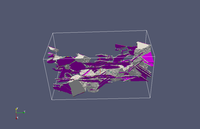
Same crack with rotating model.
3D and 1D crack artefacts are present.
This is one of the problems with the current
cleavage propagation model.

Another example, still 100 grains
A model with 100 grains
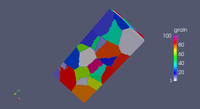
GB in a 100-grain model
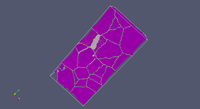
Crack in a 100-grain model after 300 iterations
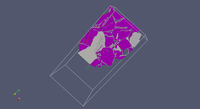
Grain competition stats
Changing grain size histograms during competition.
This is a multi-page PDF

Resolution analysis. Multiple
runs of the same model.
This is a multi-page PDF

Grain competition animation.

Examples of grain structures
300x300x300 cell array, 100 grains,
equiaxed microstructure

300x300x300 cell array, 50 grains,
solidification from the boundary
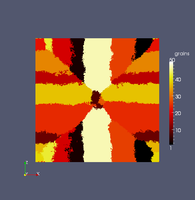
200x200x200 cell array, 500 grains,
bi-modal microstructure
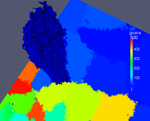
No self-similar boundary conditions
(fixed boundary). The full surface
of one grain is shown protruding from
the cross-section of the microstructure.
Columnar grains examples
150x150x150 array, 50 grains,
showing the nucleation plane.
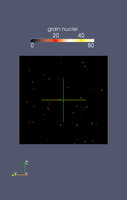
The same plane after solidification
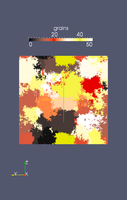
3D view of solidified microstructure,
showing columnar grains along X.
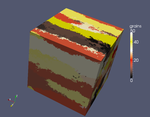
Single grains
200x200x200 array, 50 grains.
No self-similar boundary condition.

Animated single grain rotated in
space. Faces, edges and vertices
can be identified.
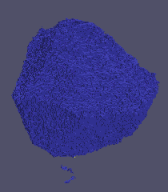
We use
Paraview
for visualisation.
A volume of material shortly after grain nucleation.
Note that the bulk of the volume is not filled yet.

A volume of material at the end of the grain growth.
Only the surface of this volume is shown.

A volume of material at the end of grain growth.
This is volume visualisation.

Other Fortran related projects
-
ABUMPACK -
Abaqus UMAT and VUMAT for GTN, Rousselier, von Mises plasticity
-
CASUP -
Cellular Automata library for HPC and supercomputers
-
Coarrays -
Fortran 2008, 2018 coarrays course - native Fortran SPMD
parallel programming
-
CMPLX -
Validation of Fortran 2008
complex intrinsics and minus zero on branch cuts
-
OPTPACK -
OPTimisation PACKage - multi-start global
optimisation in Fortran 2003 driven with shell scripts
-
SCNU -
Side Cut Non-Uniform residual stress measurement method
-
disp2sif -
Calculation of
mixed mode (I+II) stress intensity factors (SIF)
from crack tip displacements
-
erf -
Error functions of complex arguments, erf(z), implemented in modern Fortran
validate this page





